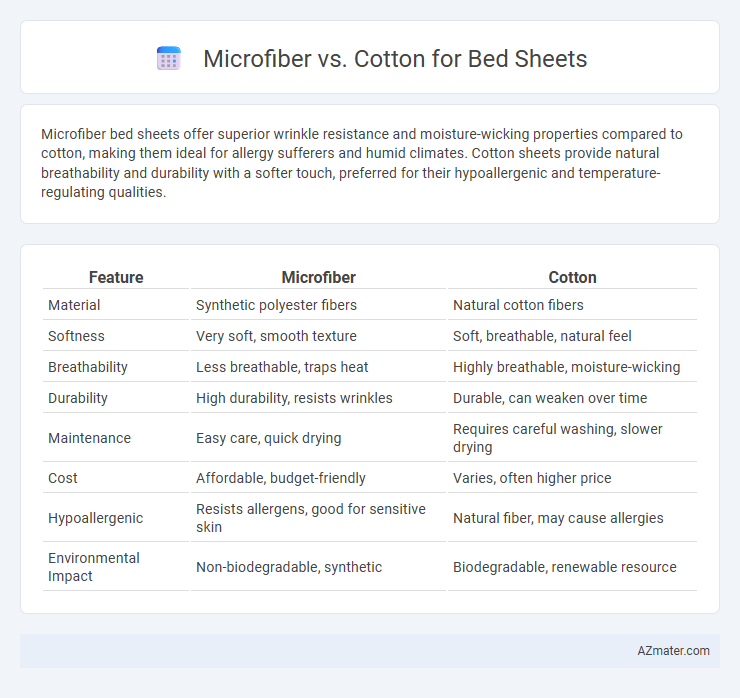Microfiber bed sheets offer superior wrinkle resistance and moisture-wicking properties compared to cotton, making them ideal for allergy sufferers and humid climates. Cotton sheets provide natural breathability and durability with a softer touch, preferred for their hypoallergenic and temperature-regulating qualities.
Table of Comparison
| Feature | Microfiber | Cotton |
|---|---|---|
| Material | Synthetic polyester fibers | Natural cotton fibers |
| Softness | Very soft, smooth texture | Soft, breathable, natural feel |
| Breathability | Less breathable, traps heat | Highly breathable, moisture-wicking |
| Durability | High durability, resists wrinkles | Durable, can weaken over time |
| Maintenance | Easy care, quick drying | Requires careful washing, slower drying |
| Cost | Affordable, budget-friendly | Varies, often higher price |
| Hypoallergenic | Resists allergens, good for sensitive skin | Natural fiber, may cause allergies |
| Environmental Impact | Non-biodegradable, synthetic | Biodegradable, renewable resource |
Introduction to Bed Sheet Fabrics
Bed sheet fabrics significantly impact comfort, durability, and maintenance, with microfiber and cotton being two of the most popular choices. Microfiber, made from finely woven synthetic fibers such as polyester, offers smoothness, wrinkle resistance, and affordability, while cotton, a natural fiber, is prized for breathability, softness, and moisture absorption. Understanding the properties of microfiber versus cotton helps in selecting bed sheets that best suit personal preferences and sleeping conditions.
What is Microfiber?
Microfiber is a synthetic fabric made from ultra-fine polyester fibers that are thinner than a strand of silk, providing a smooth and soft texture ideal for bed sheets. Its tightly woven structure enhances durability, moisture-wicking properties, and resistance to wrinkles and stains compared to natural fibers like cotton. Microfiber bed sheets offer lightweight comfort and are often more affordable, making them a popular choice for easy maintenance and long-lasting use.
What is Cotton?
Cotton is a natural fiber derived from the seed hairs of the cotton plant, renowned for its breathability, softness, and moisture-wicking properties, making it a popular choice for bed sheets. It offers excellent durability and hypoallergenic benefits, which contribute to a comfortable and healthy sleep environment. Unlike synthetic fibers, cotton bed sheets tend to be more breathable and absorbent, regulating temperature effectively throughout the night.
Softness and Comfort Comparison
Microfiber bed sheets offer exceptional softness due to their fine synthetic fibers, providing a smooth, silky feel that resists wrinkles and retains color vibrancy longer than cotton. Cotton sheets, particularly those made from long-staple fibers like Egyptian or Pima cotton, deliver natural breathability and softness that improves with washing, enhancing comfort through moisture absorption and temperature regulation. For individuals seeking durable softness with easy maintenance, microfiber excels, while those prioritizing natural comfort and breathability may prefer the breathable, plush texture of high-quality cotton sheets.
Durability and Longevity
Microfiber bed sheets are composed of tightly woven synthetic fibers, providing superior durability and resistance to wear and tear compared to natural cotton. Cotton sheets, especially those made from long-staple fibers like Egyptian or Pima cotton, offer excellent strength but may degrade faster with frequent washing and exposure to sunlight. Microfiber's resistance to shrinking, fading, and wrinkling contributes to a longer lifespan, making it a cost-effective choice for longevity in bedding.
Breathability and Temperature Regulation
Microfiber bed sheets offer moisture-wicking properties but tend to retain heat due to their dense weave, making them less breathable compared to cotton. Cotton sheets, especially those made from long-staple varieties like Egyptian or Pima cotton, provide superior airflow and natural temperature regulation for a cooler, more comfortable sleep environment. The inherent breathability of cotton fibers helps dissipate body heat and moisture, reducing night sweats and promoting restful sleep.
Maintenance and Care Requirements
Microfiber bed sheets require less maintenance due to their wrinkle-resistant and quick-drying properties, making them easy to wash and care for without frequent ironing. Cotton sheets, while naturally breathable and durable, demand more attention through regular washing at higher temperatures and occasional ironing to maintain softness and prevent shrinkage. Both materials benefit from gentle detergents, but microfiber is more resistant to fading and shrinking over time, offering greater convenience in everyday care.
Cost and Affordability
Microfiber bed sheets typically cost less than cotton, making them a more affordable option for budget-conscious shoppers. Cotton sheets, especially those made from high-quality Egyptian or Pima cotton, tend to be more expensive due to their natural fibers and durability. While microfiber offers lower upfront costs, cotton's long-term durability may provide better value over time.
Environmental Impact
Microfiber bed sheets are made from synthetic materials like polyester, which are derived from petroleum and contribute to microplastic pollution when washed, posing significant environmental concerns. In contrast, cotton bed sheets, especially organic cotton, are biodegradable and sustainably farmed, reducing chemical usage and supporting soil health. Choosing organic cotton over microfiber promotes a lower environmental footprint by minimizing plastic waste and chemical pollutants in the ecosystem.
Which is Best for Your Needs?
Microfiber bed sheets offer superior wrinkle resistance and moisture-wicking properties, making them ideal for those seeking low-maintenance and durability. Cotton sheets, especially high-quality Egyptian or Pima cotton, provide breathability and a natural feel that suits sleepers who prioritize comfort and temperature regulation. Choosing between microfiber and cotton depends on individual preferences regarding softness, allergy potential, and care requirements.

Infographic: Microfiber vs Cotton for Bed Sheet
 azmater.com
azmater.com